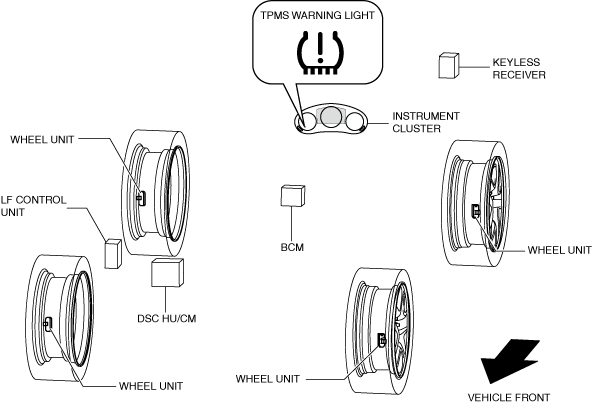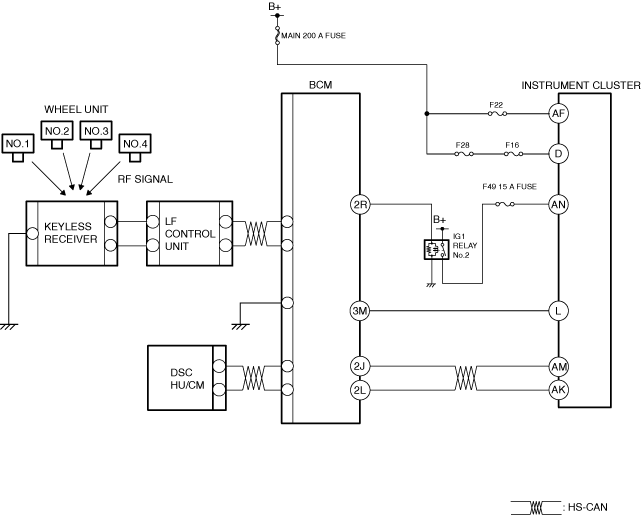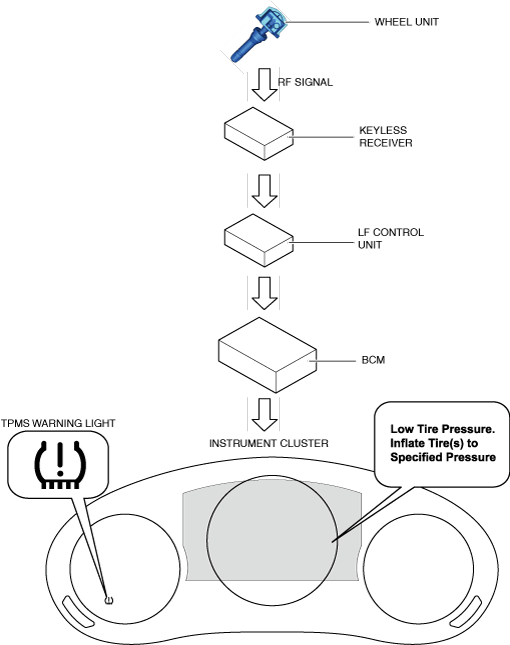TIRE PRESSURE MONITORING SYSTEM (TPMS) [(US)]
TIRE PRESSURE MONITORING SYSTEM (TPMS) [(US)]
SM2334011
id0212002010x1
Purpose
-
Caution
-
• A wheel unit installed to each wheel has its own preset identification code. If a component part is replaced, the system becomes inoperative because the BCM cannot recognize the identification codes. Therefore, always perform the identification code configuration for the wheel units when any of the following items have been performed. For the identification code configuration procedure, refer to the workshop manual.
-
― Wheel unit replacement― LF control unit replacement
-
-
Note
-
• Adjust the tire pressure before driving (When tires are cold)• Tire pressure changes due to changes in the ambient temperature and the internal temperature of a tire.
-
― In regions and seasons with changing temperatures, the tire pressure changes due to ambient temperature changes. If the tire pressure is lower than the lower-limit pressure due to low ambient temperature, the TPMS warning light may turn on. When the TPMS warning light turns on, adjust the tire pressure.― Tire pressure is high after driving because the internal temperature of the tires is high. If the tire pressure is adjusted to the standard when the internal temperature of the tire is high, the tire pressure lowers when the internal temperature decreases to the same level as the ambient temperature. If the tire pressure decreases below the lower-limit pressure, the TPMS warning light might turn on.
• Generally, if the temperature changes by 10 °C {18 °F}, the air pressure changes by 10 kPa {0.10 kgf/cm2, 1.5 psi}. -
Functions
-
― Identification code recognition function
-
• Identifies whether the signals from the wheel units are those of the vehicle.
― Tire pressure determination/warning function-
• Determines whether the tire pressure information transmitted from the wheel units is within the specified range.• If the tire pressure is lower than the specification, it alerts the driver using the TPMS warning light.
-
Construction
|
Part name |
Function |
|
|---|---|---|
|
Wheel unit
|
• Monitors the air pressure, temperature, and acceleration rate of each tire, and sends RF signals.
• Sends information if any malfunction is detected in the wheel unit.
• Operates based on the battery built into the wheel unit. If the remaining battery level is low, a warning is displayed on the multi-information display.
|
|
|
LF control unit
|
• Transmits the information from the wheel units to the instrument cluster.
• Performs the wheel unit position learning based on the signals from the wheel unit and ABS wheel-speed sensor. Wheel unit position learning function
|
|
|
BCM
|
• Receives information from the LF control unit and monitors the air pressure of each tire.
• If it determines that the tire pressure is abnormal, it sends a TPMS warning light on request signal to the instrument cluster.
|
|
|
DSC HU/CM
|
Wheel-speed signal
|
• Inputs the wheel-speed signal to the BCM via CAN communication.
|
|
Instrument cluster
|
• If the BCM detects abnormal tire pressure or a system malfunction, it turns on the TPMS warning light to alert the driver.
|
|
System structural view
am3zzn00008755
|
System wiring diagram
am3zzn00008192
|
Operation
am3zzn00008756
|
Identification code recognition function
-
• The BCM configures the identification codes of the wheel units equipped to the vehicle and it has a function for verifying the identification codes sent from the wheel units against the configured identification codes.• If the received identification codes match the configured identification codes, the information such as the tire pressure is updated based on the received RF signals. If the identification codes do not match, the information of those signals is ignored.
The wheel unit position learning function
-
• The LF control unit determines which tire a wheel unit is installed to by comparing the timing in which the RF signal is received with the tire rotation angle information.(See WHEEL UNIT [(US)].)• Tire rotation angle information is sent to the LF control unit from the ABS wheel-speed sensor.(See ABS WHEEL-SPEED SENSOR AND ABS SENSOR ROTOR.)• The LF control unit determines which tire a wheel unit is installed to by comparing the timing in which the RF signal is received with the tire rotation angle information.
Tire pressure determination and warning function
-
• The BCM determines the pressure condition of each tire by comparing the tire pressure information received from the wheel units with the value preset in the BCM.• If an abnormality is detected from the received signals, the instrument cluster flashes the TPMS warning light to notify the driver of the tire abnormality.• Notification/warning concerning abnormal tire pressure determination takes priority over wheel unit signal missing or malfunction determination notification/warning.
-
Low pressure determination
-
• If the tire pressure information indicates a tire pressure that is below the specification configured in the BCM, the BCM determines that the air pressure of the tire installed on the particular wheel unit is low.
-
― If low tire pressure is determined while the ignition is switched ON (engine off or on), the TPMS warning light is turned on to alert the driver.― If low tire pressure is determined while the ignition is switched OFF, the BCM performs an open-circuit check *1 on the TPMS warning light after the ignition is switched ON (engine off or on) and it turns on the TPMS warning light to alert the driver. *1: The instrument cluster turns on the TPMS warning light for 3 s after the ignition is switched ON to do an open-circuit check on the TPMS warning light.
• The low-pressure determination remains in effect until tire pressure information sent from the applicable wheel unit returns to the specified value.-
― If tire pressure information is received that indicates tire pressure exceeding the specified value while the ignition is switched ON (engine off or on), the BCM turns the TPMS warning light off.― If high tire pressure is determined while the ignition is switched OFF, the BCM performs an open-circuit check *1 on the TPMS warning light after the ignition is switched ON (engine off or on) and it turns OFF the TPMS warning light. *1: The instrument cluster turns on the TPMS warning light for 3 s after the ignition is switched ON to do an open-circuit check on the TPMS warning light.
-


